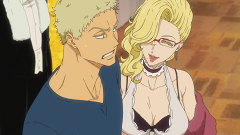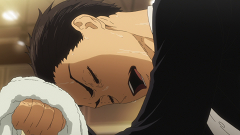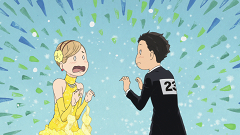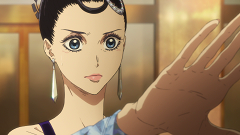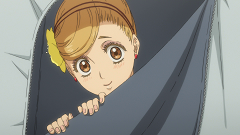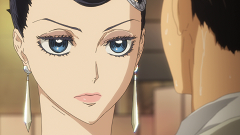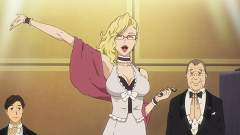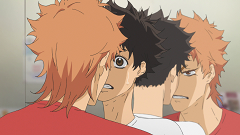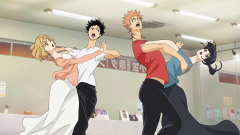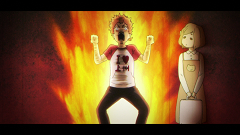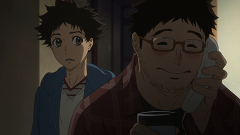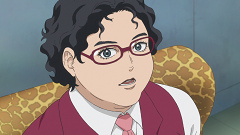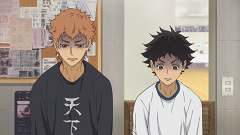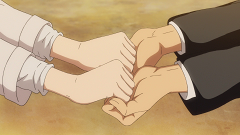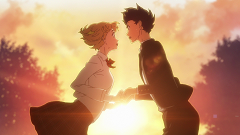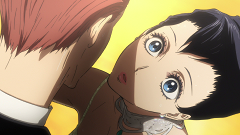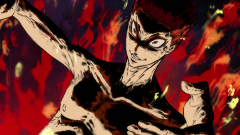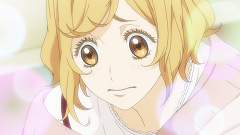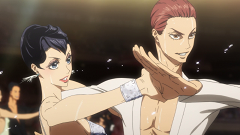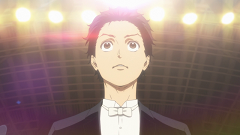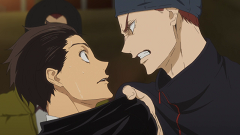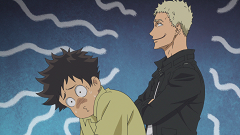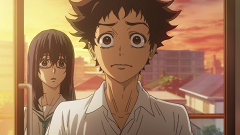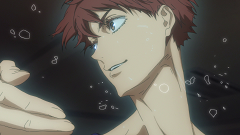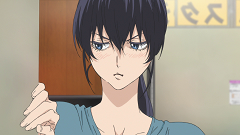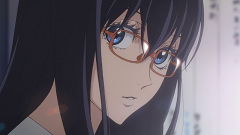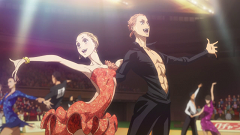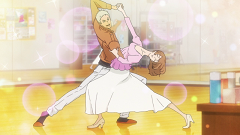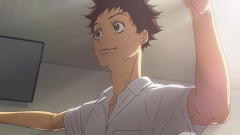Here are a few reasons why Hyodo Kiyoharu was the MVP of this week’s episode: he noticed Tatara’s fatigue and flat-footedness before the kid’s own coach. He kept his cool while everyone else was busy flinging petty insults or embroiling themselves in love pentagons, and provided his rival with both straight talk and sound advice. He watched his mom flirt unashamedly with a guy nearly twice her age, and somehow managed to retain his dignity. He managed to motivate someone as talented as Shizuku to dance her best with his mere presence. And he looked fly as hell with his sweater robe and crutch, even amidst a sea of tailcoats and bowties. If I were a judge at the Tenpei Cup, I’d call off the competition and just award Hyodo the trophy.
Unfortunately, I’m not qualified to evaluate ballroom dancing (or men’s fashion) – only to talk about Japanese cartoons. So despite Hyodo’s greatness, there’s one scene I really want to focus on this week, and that’s the moment when Sengoku instructs Tatara not to do the special Quickstep variation they’d been practicing for weeks. Even without seeing his pupil gasp for breath in the corner of the room just moments beforehand, Sengoku knows that Hyodo is right about his exhaustion. Tatara is already on the floor by the time he can speak with him, though, so Sengoku is forced to shout across the hall not to use their trump card (which would likely result in his collapse). What follows is dead silence, and eventually a shot of Tatara, who looks exhausted and embarrassed, but more than that, he looks crushed. He’s upset that his coach doesn’t believe in him, even though he’s shaking and sweating and barely maintaining his hold on his partner. This is a boy with prior self-image issues being told to alter his routine to account for his lack of experience and stamina; it’s no wonder he sobs and collapses in Sengoku’s arms after his neutered performance.
I’m glad that Ballroom continues to expose this side of Tatara, even if the results are sometimes hard to watch, because it makes him more human even as the shounen clichés pile around him. The Destined Rivals bit that he and Hyodo have going on is farfetched, though the show played it well this week by making Kiyoharu the voice of reason during an emotional scene. “Reality” is the title of this episode, and Tatara’s reality, as explained by his rival, is that he can’t possibly beat Gaju given his current lack of talent and conditioning. The solution is to allow Mako to outperform Shizuku, and that’s a plan I couldn’t be happier with, especially after two months of hearing that the man leads and the woman follows, the pair’s score is largely determined by the leader, etc. I don’t doubt the truth of those statements, since ballroom dancing is quite traditional, but when Mako asks Tatara to “make me bloom” at the episode’s end, it feels great to know that she’s allowing herself to command some attention for a change. That final line also carries with it a hint of romance, given the sensual connotation that blooming holds. Sengoku teased the two kids about a potential relationship midway through the proceedings this week, so I expect that their partnership may become a bit more complicated in the future.
Love is in the air for several other characters, as well, but Shizuku’s crush is the most interesting. She looked stunned after seeing Hyodo at the Tenpei Cup, perhaps for the first time since his hospitalization, which is a total reversal from her invulnerable attitude just hours earlier. Tatara tries to explain away Hyodo’s strategy as a plan to separate her from Gaju, but she still feels him slipping away, as she did back in episode two. Her resolve now is to impress her former partner, which is an okay development in my book. This is an unsanctioned event with nothing on the line for a seasoned pro like Shizuku, so what’s the harm in a little showmanship for the sake of the boy she likes? Besides, her desire to impress Kiyoharu is tied to her need to reach his skill level, and prove to upstarts like Tatara that you can’t waltz into this scene and start winning trophies left and right – pun very much intended.

